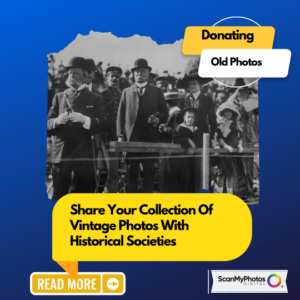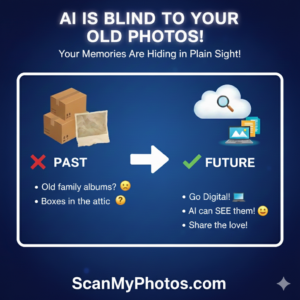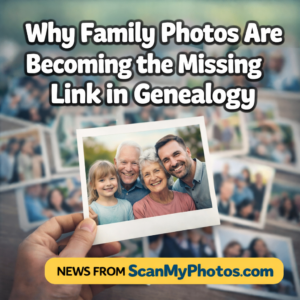We explore in today’s PICTURE THIS! how to share your archives of old-school photographs, slides, and home movies with historical societies and museums. After digitizing pictures, we often hear from people eager to share their history and archives of newly digital files.

Suppose you have vintage photographs you don’t know what to do with, such as those of your family, locality, or even places you’ve traveled to. In that case, you can contribute to historical societies, libraries, and museums nationwide. Such organizations are forever searching for additional images to add to their catalogs, and your photographs could help them keep historical memories alive.
Preserving History through Photographs: Sharing Your Old-School Family Archives with Historical Societies and Museums
Today, the digital age has made preserving our cultural heritage and artifacts crucial. Photographs, slides, and movies serve as essential historical records that can reveal past experiences, our communities’ progress, and stories that can only be shared in this way. Connecting with local or national historical societies, libraries, and museums is essential to ensure these memories remain preserved. Doing so not only allows us to protect the Americana of our ancestors, but to build an understanding of our collective history. If you find yourself with old photos, here is how you can contribute meaningfully to these organizations.
<< Click here if your archives of analog photo content haven’t already been digitized >>
The Significance of Preserving Culture and Americana Artifacts:
Documenting cultural and Americana artifacts through photography is imperative for numerous grounds. To begin with, these visual chronicles depict the habits, ceremonies, and everyday lives of individuals and communities, revealing the luxuriant weave of our cultural legacy. They provide essential primary sources for investigators, historians, and future generations trying to comprehend the past.
Moreover, old pictures tie to individual and familial histories. It permits people to link with their foundations and legacy. By disclosing these photos of your story, you contribute to a more extensive story that glorifies diverseness, incites sympathy, and instills a more profound admiration for our shared identity.
Reaching Out to Historical Societies, Libraries, and Museums: If you possess old photographs, slides, or home movies with historical significance, consider reaching out to them. These organizations actively seek new additions to their collections to expand their resources and enhance public access to historical materials.
- Start Locally: Begin your search online to locate historical societies, libraries, and museums in your local area. They often have dedicated archivists or curators responsible for managing and preserving photographic collections. Contact them via email or phone or by visiting their facilities in person. Provide a brief description of your collection, its historical context, and express your interest in contributing to their archives.
- Research Online: Most archival organizations have websites that outline their collection policies and procedures for accepting donations or loans of photographs. Familiarize yourself with their requirements and guidelines to ensure your submission aligns with their focus areas and goals.
- Collaborate with Curators: Once you establish contact, dialogue with the curators or archivists. They will guide you through the process of sharing your archives, discuss the possibility of digitizing the materials for broader accessibility, and provide any necessary forms or agreements for donation or loan.
- Consider Copyright and Permissions: Before sharing your photographs, consider any copyright issues or permissions required for public display or reproduction. Discuss these matters with the receiving institution. They often have protocols in place to address legal aspects and provide guidance on obtaining necessary permissions.
BONUS: SIGN UP HERE FOR INSTANT DISCOUNTS AND NEWS UPDATES FROM SCANMYPHOTOS.COM
The Impact of Your Contribution: By making your archives accessible to organizations like historical societies, libraries, and museums, you are investing in the conservation and propagation of our past for the benefit of upcoming generations. Your photographs become important references for researchers, academics, and the public, resulting in a heightened comprehension of our shared heritage. In doing so, you actively protect our culture, identity, and national artifacts.
News Profiles:
- “Preserving Family History: How to Share Your Old Photos with Museums.” [PBS: “Museum of Lost Memories helps reunite misplaced family mementos with their owners.”]
- “The Power of Visual Heritage: Donating Your Old-School Photographs to Historical Societies” [“San Diego Union-Tribune: “The Oceanside Public Library is working with the Hill Street Country Club and Oceanside Historical Society to put together an exhibit on significant cultural events in Oceanside’s history and seeks photographs and stories from the public”Connecting the Past and Present: Local Libraries Seek Old Photos for Historical Collections.”]
- “Preserving WWII Photos. [The National WWII Museum, New Orleans: “Preservation of Artifacts.”]
ScanMyPhotos has compiled a list of historical societies, libraries, and museums that collect and display nostalgic photo collections. You can also do an online search for your local organization that may be interested in your family history and those photographs.
List of our favorite U.S. historical societies, federal and state archives, libraries, and museums that collect and display nostalgic photo collections.
- Library of Congress (@librarycongress): The Library of Congress is the national library of the United States. It has a vast collection of photographs, including many that are nostalgic.
- National Archives and Records Administration (@NARA): The National Archives and Records Administration is the federal agency responsible for preserving and documenting government and historical records. It has an extensive collection of photographs.
- National Archives and Records Administration.
- Smithsonian National Museum of American History. It is one of the largest museums in the world. It has a vast collection of artifacts, including many photographs, and documents on American history.
- Smithsonian National Museum of American History.
- California Historical Society (@calhistorical) is a non-profit organization that collects, preserves, and interprets California history. It has an extensive collection of photographs.
- New York Historical Society (@nyhistory) is a private research library and museum.
- San Francisco Museum of Modern Art (@sfmoma) is a Museum of Modern Art.
- Museum of the City of New York (@mcny) is a museum that tells the story of New York City.
- Los Angeles County Museum of Art (@LACMA) is a modern and contemporary art museum.
- Winterthur Museum, Garden & Library (@Winterthur). Winterthur is a museum and research library that tells the story of American decorative arts.
- Henry Ford Museum (@TheHenryFord) tells the story of American innovation. It has a collection of over 26 million artifacts, including many photographs, that document American history.
- National Civil Rights Museum (@NationalCivilRights) tells the American civil rights movement story.
- The National Museum of the American Indian (@NMAI) is a museum that tells the story of American Indian and Alaska Native cultures.
- National World War II Museum (@nationalww2museum) tells the story of World War II. It has a collection of over 20 million artifacts.
- Dayton Aviation Heritage National Historical Park (@daytonavlheritage) tells the story of aviation history.
- Independence Hall (@IndependenceHall) is a building that is famous for being the site where the Declaration of Independence and the Constitution of the United States were signed.




